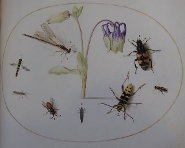Where taxonomy and biology are concerned, my knowledge begins and end with Carl Linnaeus, the Swedish scientist who ushered in modern taxonomy. It was with some surprise that I find out artists also helped develop the field. From a June 21, 2016 news item on ScienceDaily,
In the sixteenth and seventeenth centuries artists were fascinated by how the animal kingdom was classified. They were in some instances ahead of natural historians.
This is one of the findings of art historian Marrigje Rikken. She will defend her PhD on 23 June [2016] on animal images in visual art. In recent years she has studied how images of animals between 1550 and 1630 became an art genre in themselves. ‘The close relationship between science and art at that time was remarkable,’ Rikken comments. ‘Artists tried to bring some order to the animal kingdom, just as biologists did.’
A June 21, 2016 Universiteit Leiden (Leiden University, Netherlands) press release, which originated the news item, expands on the theme,
In some cases the artists were ahead of their times. They became interested in insects, for example, before they attracted the attention of natural historians. It was artist Joris Hoefnagel who in 1575 made the first miniatures featuring beetles, butterflies and dragonflies, indicating how they were related to one another. In his four albums Hoefnagel divided the animal species according to the elements of fire, water, air and earth, but within these classifications he grouped animals on the basis of shared characteristics.
The press release goes on,
Other illustrators, print-makers and painters tried to bring some cohesion to the animal kingdom. Some of them used an alphabetical system but artist Marcus Gheeraerts published a print as early as 1583 [visible below, Ed.] in which grouped even-toed ungulates together. The giraffe and sheep – both visible on Gheeraerts’ print – belong to this species of animals. This doesn’t apply to all Gheeraerts’ animals. The mythical unicorn, which was featured by Gheeraerts, no longer appears in contemporary biology books.
Wealthy courtiers
According to Rikken, the so-called menageries played an important role historically in how animals were represented. These forerunners of today’s zoos were popular in the sixteenth and seventeenth centuries particularly among wealthy rulers and courtiers. Unfamiliar exotic animals regularly arrived that were immediately committed to paper by artists. Rikken: ‘The toucan, for example, was immortalised in 1615 by Jan Brueghel the Elder, court painter in Brussels.’ [See the main image, Ed.].’
In the flesh
Rikken also discovered that the number of animals featured in a work gradually increased. ‘Artists from the 1570s generally included one or just a few animals per work. With the arrival of print series a decade later, each illustration tended to include more and more animals. This trend reached its peak in the lavish paintings produced around 1600.’ These paintings are also much more varied than the drawings and prints. Illustrators and print-makers often blindly copied one another’s motifs, even showing the animals in an identical pose. Artists had no hesitation in including the same animal in different positions. Rikken: ‘This allowed them to show that they had observed the animal in the flesh.’
Yet more proof or, at least, a very strong suggestion that art and science are tightly linked.

